Edward VIII Gold Sovereign – One of the Rarest Coins in British History
08/11/2024Daniel Fisher
Free & fully insured UK Delivery. Learn more
Secure & flexible payments. Learn more

Buyback Guarantee Learn more
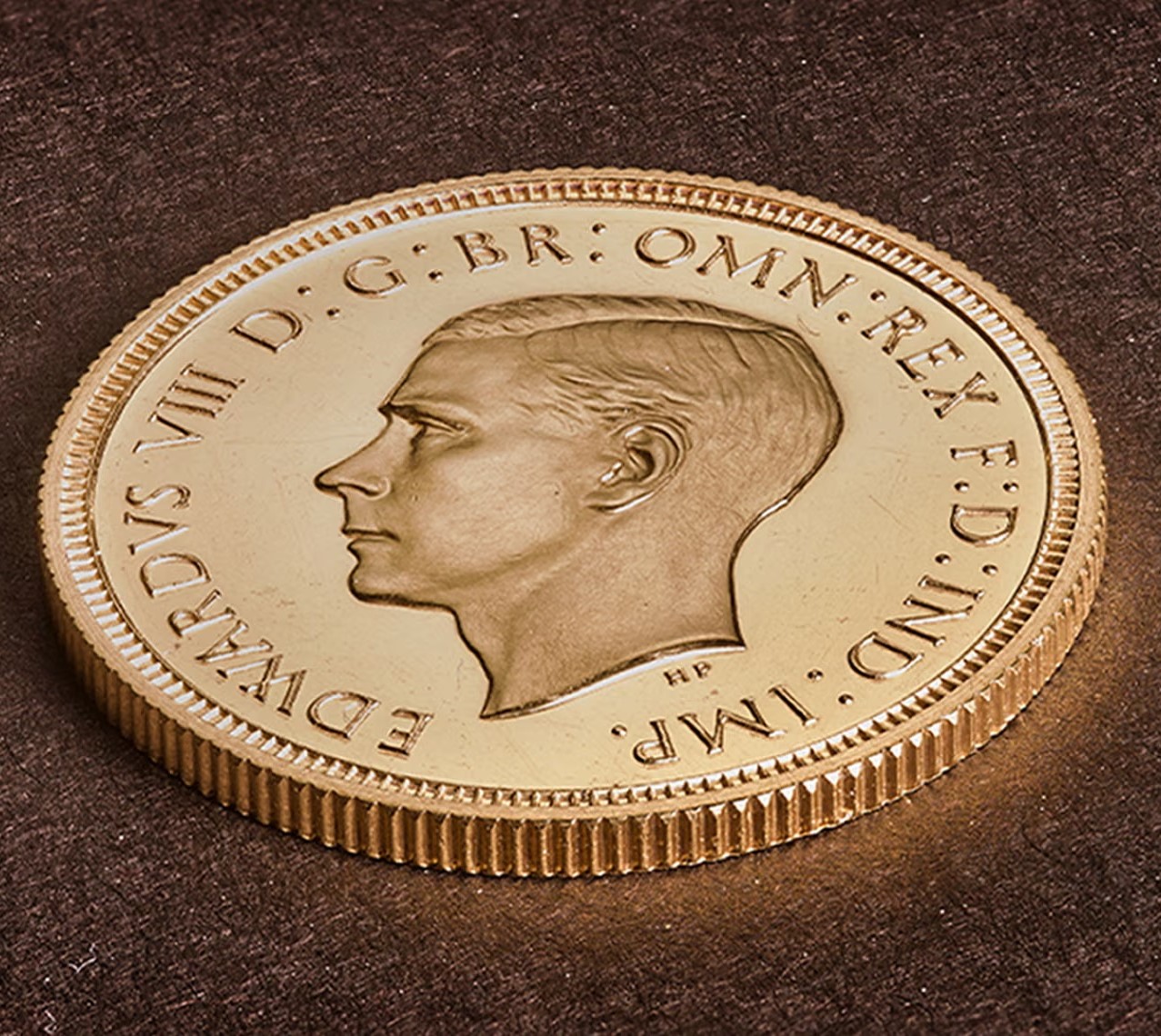
The story of Edward VIII is one of the most fascinating chapters in British royal history. Familiar to any fans of Netflix drama The Crown, he was known as the king who famously abdicated the throne to marry Wallis Simpson, an American divorcée. Edward’s reign lasted less than a year, making him one of Britain’s shortest-reigning monarchs.
While his decision to step down forever changed the British monarchy, it also left an intriguing mark on numismatics—the world of coin collecting.
The Edward VIII sovereign coins are among the rarest British coins, capturing the interest of collectors, investors, and historians alike. With only a handful ever minted and none released for circulation, these coins are not only prized for their scarcity but also for their unique design, which broke a long-standing royal tradition.
Edward VIII was a British monarch whose brief reign and personal choices sparked one of the greatest controversies in modern royal history. Born on June 23, 1894, as the eldest son of King George V and Queen Mary, Edward was charismatic, popular, and widely regarded as a modern prince, bringing a fresh approach to the traditional monarchy. His path to the throne seemed clear—until he fell in love with Wallis Simpson, an American socialite who was twice divorced.
Edward ascended the throne in January 1936 after his father’s passing. However, his reign quickly became overshadowed by his relationship with Wallis, a relationship that went against the Church of England’s teachings at the time. As king, Edward was also the Supreme Governor of the Church of England, which prohibited the remarriage of divorced individuals with living ex-spouses. Faced with the choice between the throne and his love for Wallis, Edward chose to abdicate in December 1936, becoming the first British monarch to voluntarily relinquish the crown.
After abdicating, Edward became the Duke of Windsor and married Wallis Simpson in 1937. The couple spent much of their lives in France, far from the British throne and public eye. Although Edward’s time as king was brief, it left an indelible mark on history and royal protocol. His decision also led to an extraordinary legacy in coinage. The coins prepared during his short reign, including the sovereign coin, remain among the rarest and most coveted by collectors due to their unique backstory and limited production.
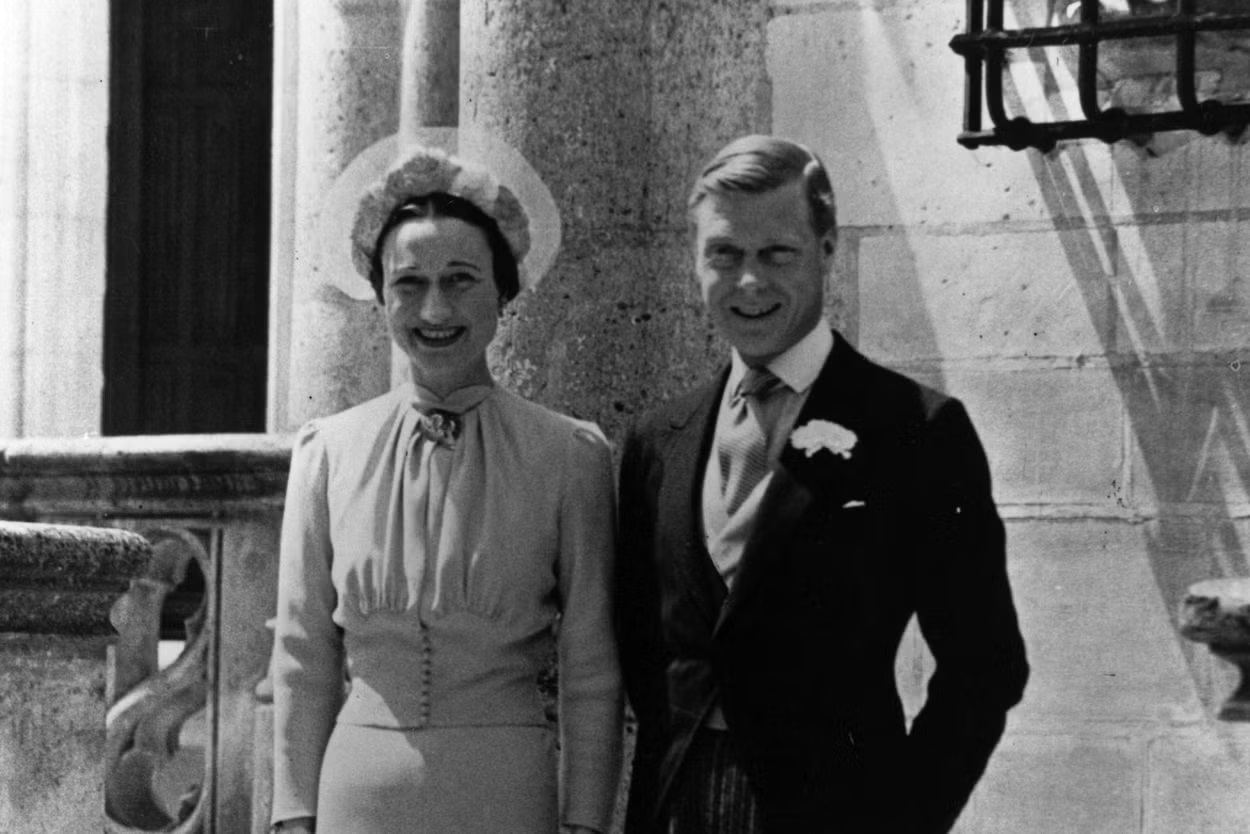
Duke of Windsor and Mrs Wallis Simpson on their wedding day at Chateau de Conde, France. (Getty Images)
The Edward VIII coins are some of the rarest in British history, with only a handful ever produced—and none officially released to the public. The story behind these elusive coins begins with Edward’s brief and controversial reign, which disrupted the usual processes of minting and distributing new coinage for a monarch. His abdication, combined with his unconventional choices for his coins’ design, created a perfect storm of rarity and intrigue, making these coins extraordinarily valuable for collectors today.
Typically, when a new monarch ascends the throne, the Royal Mint begins designing and producing new coins to replace those of the previous ruler. For Edward VIII, this process started in early 1936. Several coin designs were prepared, including sovereigns, crowns, and other denominations. However, Edward’s unexpected abdication at the end of that year threw the entire process into disarray.
Once Edward stepped down, the minting of his coins was abruptly halted. The sovereigns and other coins featuring his likeness were never put into official circulation, and most of them were either destroyed or withheld by the Royal Mint. As a result, only a few prototype coins survived, many of which are in the possession of museums or private collectors. Because no Edward VIII coins were distributed to the public, the few that do exist are incredibly rare and command exceptionally high prices at auction, demonstrating the wide variance in values between different Sovereign coins.
Adding to the coins’ uniqueness is a small yet significant detail: Edward VIII broke with a centuries-old tradition regarding the direction of the monarch’s portrait. Traditionally, British monarchs alternate the direction in which their profile faces on coins with each new reign. Following this custom, Edward’s portrait should have faced right, as his predecessor, George V, faced left. However, Edward preferred his left side and insisted that his portrait also face that way—a decision that defied royal tradition.
This choice sparked controversy within the Royal Mint, as it challenged a long-standing rule that had been followed for centuries. Edward’s insistence on this detail made the design of his coins even more distinctive. As a result, the Edward VIII sovereign coin remains unique in the lineage of British coinage, with an unconventional portrait that adds further appeal and mystery to its story. The subsequent George VI Sovereign coins also faced left, demonstrating the disapproval of Edward’s choice, by almost dismissing its left-facing aspect.
Free ultimate guide for keen precious metals investor
The Edward VIII sovereign coin stands out in British coinage not only because of its rarity but also for its distinct and thoughtful design. Despite Edward’s brief reign, the Royal Mint crafted a coin that reflects his personal style and preferences, setting it apart from other sovereigns. The coin’s design is as unique as its history, capturing the essence of a modernizing monarch who, in subtle ways, challenged long-held traditions.
Beyond its design and controversial portrait aspect, the Edward VIII sovereign coin features the technical specifications typical of British gold sovereigns. Made from 22-carat gold, the coin has a diameter of 22 millimetres and weighs approximately 7.98 grams. The coin’s edge is milled, a traditional detail that not only enhances its appearance but also helps prevent counterfeiting.
The reverse side of the coin features the classic design of Saint George slaying the dragon, a motif created by the renowned engraver Benedetto Pistrucci. This iconic design has been a staple of British sovereign coins for over a century, symbolizing strength, bravery, and victory. The Edward VIII sovereign follows this tradition on its reverse, blending a classic symbol with a modernized, personal portrait of the king on its obverse.
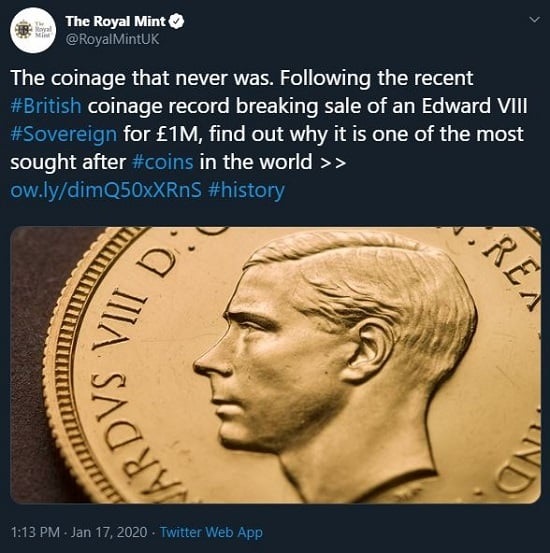
The Edward VIII sovereign coins are among the most coveted options in the world of coin collecting, commanding record-breaking prices and a level of prestige rare even among historic British coins. Due to their scarcity, historical significance, and unique design, these coins hold immense value.
In 2020, the Royal Mint announced that one of these sovereigns sold for an astonishing £1 million, highlighting its status as one of the rarest and most sought-after coins in British history. This sale solidified the Edward VIII sovereign’s reputation as a symbol of rarity, exclusivity, and allure in the numismatic market.
For collectors, the Edward VIII sovereign is a true “holy grail” of British coinage. Its rarity and historical context make it particularly attractive to high-end collectors and those fascinated by the dramatic events of Edward VIII’s short reign. The coin’s appeal goes beyond its design; it represents a fascinating piece of history, tied to a king who abdicated the throne for love and defied royal tradition by opting for an unconventional left-facing portrait.
Owning an Edward VIII sovereign is, therefore, not only about possessing a rare item but also about holding a tangible link to a historic royal controversy. The intrigue and symbolism associated with these coins make them prized assets in prestigious collections, with very few collectors worldwide ever able to claim ownership. However, their rarity and associated value mean that most enthusiasts can only dream of owning one.
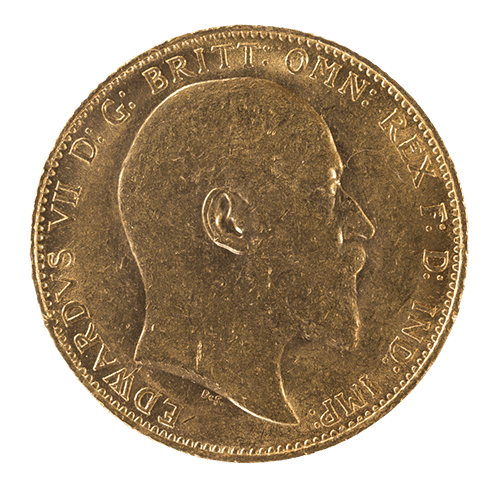
While the Edward VIII sovereign is undoubtedly an incredible asset, it’s typically not a practical investment for most collectors and investors. Its extreme rarity and high price point mean that only a few are ever available on the market, and their value largely comes from their unique story and scarcity rather than intrinsic precious metal content.
Even if one became available, it’s purchase would represent great investment risk due to the subjective nature of its value. Liquidity could also be compromised as selling the coin on would possibly require patience to find suitable buyers. Therefor it’s certainly not the best Sovereign for investors to buy.
Most investors in the coin market can either choose to buy new Sovereigns rather than old or better value historic British coins. The most obvious option would be to go for the far more accessible and affordable Edward VII Sovereign coins from 1901-1910. These combine a satisfying sense of history, being three decades older than the later Edward VIII coins, but at reasonable premiums.
Given the extreme rarity and high value of Edward VIII sovereign coins, verifying their authenticity is essential for any potential buyer. With only a handful of genuine coins ever produced and none officially released into circulation, these sovereigns are prime targets for forgeries. Ensuring that an Edward VIII coin is genuine requires a careful evaluation of its provenance, an understanding of specific design features, and, ideally, authentication from a trusted third party.
For a coin as rare as the Edward VIII sovereign, provenance is one of the most important indicators of authenticity. Legitimate coins will typically come with extensive documentation, tracing ownership back to their origins at the Royal Mint. This record may include certificates, auction records, or other documentation from reputable dealers or auction houses. Collectors should carefully review any accompanying paperwork to confirm the coin’s lineage and verify that it aligns with the known history of Edward VIII sovereigns.
Given the coin’s rarity and value, having an Edward VIII sovereign authenticated by an established expert or third-party certification service is highly advisable. Professional numismatists use specialized tools to assess the coin’s metal content, weight, and details under magnification, ensuring no aspect of the coin is inconsistent with known authentic pieces.
Because of the coin’s uniqueness, prospective buyers should only seek Edward VIII sovereigns from reputable sources. Some of the most trusted avenues include:
As the originator of Edward VIII sovereigns, the Royal Mint occasionally holds or auctions these rare coins, offering a reliable source for authentic items.
Prestigious auction houses such as Sotheby’s, Christie’s, and Heritage Auctions have a long history of handling high-value numismatic items and usually guarantee authenticity. They also provide detailed provenance and expert certifications.
The British Numismatic Trade Association (BNTA) and other international numismatic associations can help locate trusted gold dealers who specialize in high-value British coins. Such dealers adhere to strict standards, offering assurance in authenticity and fair pricing.
Professional Coin Grading Service (PCGS) and Numismatic Guaranty Corporation (NGC) are renowned for their rigorous authentication processes. A certified Edward VIII sovereign from either service includes detailed grading and authenticity verification.
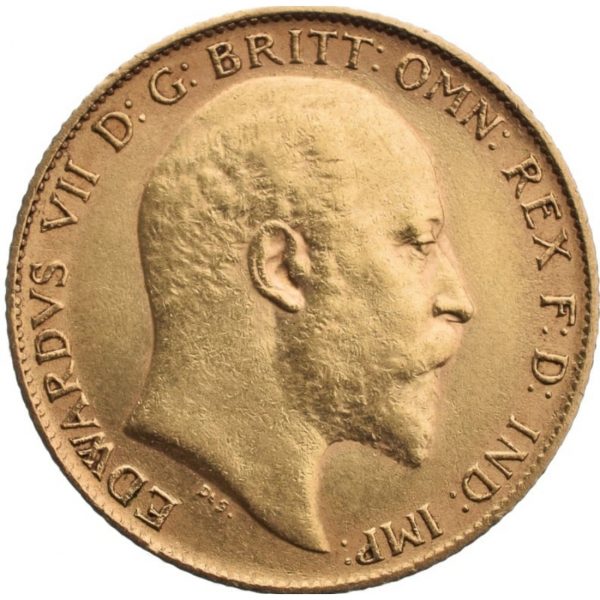
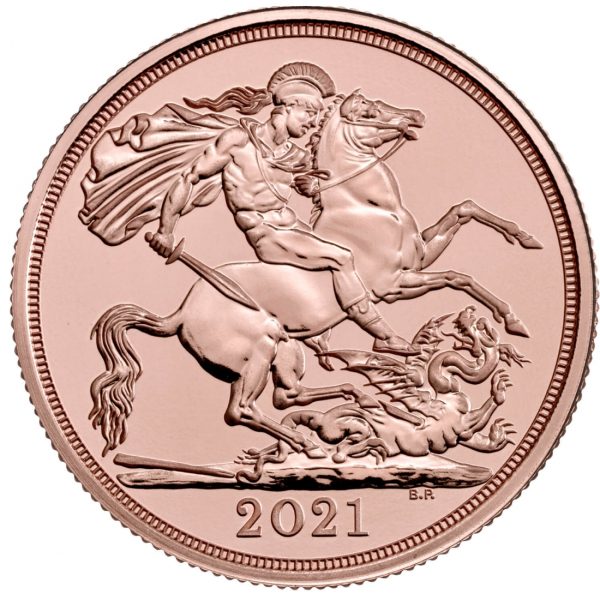
Yes, there are coins featuring Edward VIII, but they are extremely rare. While no coins were officially circulated due to his abdication in 1936, a few pattern coins were produced and are now highly valuable collector’s items. The Royal Mint Museum holds some of the finest examples of these pattern coins.
Generally Edward VII Sovereigns aren’t rare. However, those minted in limited quantities at branch mints like Ottawa (marked with a “C”) and Sydney have increased scarcity and value. Coins from 1908, 1909, and 1910 are particularly sought after by collectors, making them highly valuable.
The rarest coin in the world is the 1794 Flowing Hair Silver Dollar, believed to be the first silver dollar minted in the U.S. Only a few are known to exist, with one specimen selling for over $10 million. Its rarity, historical significance, and condition make it one of the most valuable coins globally.
Image credits: Independent.co.uk
Live Gold Spot Price in Sterling. Gold is one of the densest of all metals. It is a good conductor of heat and electricity. It is also soft and the most malleable and ductile of the elements; an ounce (31.1 grams; gold is weighed in troy ounces) can be beaten out to 187 square feet (about 17 square metres) in extremely thin sheets called gold leaf.
Live Silver Spot Price in Sterling. Silver (Ag), chemical element, a white lustrous metal valued for its decorative beauty and electrical conductivity. Silver is located in Group 11 (Ib) and Period 5 of the periodic table, between copper (Period 4) and gold (Period 6), and its physical and chemical properties are intermediate between those two metals.